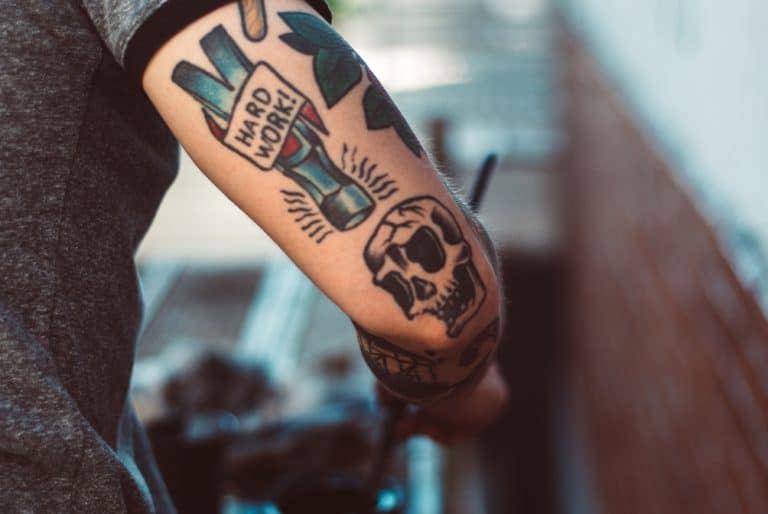You’re probably getting a tattoo for the first time or you’re more experienced and are rocking multiple tattoos.
Whatever the case is, you’re looking for an effective and affordable way to prevent your healing tattoo from getting infected or damaged and you heard that the jar of Aquaphor sitting in your medicine cabinet just might be it.
Although it is not a product designed specifically for tattoo aftercare, Aquaphor is commonly recommended by tattoo professionals for keeping your freshly-inked skin hydrated and protected.
If you’re considering trying it or you haven’t even heard of it, this article gives you a detailed account of what it is and if it is good for your new tattoo.
What is Aquaphor anyway?
Aquaphor is a skin ointment that has been around for decades. A major constituent of this ointment is petroleum jelly which uses its hydrophobic properties to form an adherent layer over the skin surface on which it’s applied.
This layer serves to prevent evaporation of fluid from the skin and hence, retaining the moisture on the surface of the skin. Also, due to its high petroleum jelly content, Aquaphor inherently offers some soothing properties and forms a physical barrier against bacteria and infective organisms.
Additional ingredients like mineral oils and cresins in the ointment provide additional protection for your new tattoo.
Bisabolol which is extracted from the chamomile plant is a minor natural component of Aquaphor that is known for its inherent anti-inflammatory and soothing properties.
It contains less active, stabilizing ingredients like lanolin alcohol, panthenol, and glycerine that work together with the active components to moisturize, nourish, and protect the skin.
Another great thing about this ointment is the level of versatility that it offers, as it can be used for a wide range of skin conditions and for preventing dry skin.
It can also be easily acquired over-the-counter from your local grocery or medicine stores at a very low cost.
When should I put Aquaphor on my tattoo?
Aquaphor is great for speeding the healing process in the first few days of tattoo healing after the bandage you got from the tattoo shop is removed, and you’ve properly cleaned the recently inked skin.
It is during these first few days that the wound is most prone to bacterial contamination and damage due to itching, irritation, and other physical trauma.
Ensure you clean the wound properly with mild antibacterial soap at least three times a day before applying a thin layer of Aquaphor.
How long should I use Aquaphor?
As long as you strictly adhere to all tattoo aftercare instructions and your tattoo is healing well, you want to use Aquaphor for only the first three days, about three times daily.
After this, you can switch to a lighter, water-based skin moisturizer.
At what point should I switch from Aquaphor to regular lotion?
After the first three days to a week (specified by your tattoo artist), you would eventually have to switch from Aquaphor to using a thinner, water-based lotion. At this point, the wound would have 
You may be wondering why you have to make this switch and what the difference the switch makes.
Both products offer moisturizing properties but the major difference is that the lotion is a water-based moisturizer compared to the oil-based Aquaphor.
This means that the lotion would work much better as a skin moisturizer while also letting the skin breathe compared with the more heavy-duty Aquaphor ointment.
Lotions are also easier to spread to cover larger portions of skin than Aquaphor, making it a more effective moisturizer.
To get the maximum benefits out of the lotion, it is advised that you use it at least three times a day after cleaning and drying the wound properly. This is used in place of Aquaphor after the first three days and/or when the wound stops oozing plasma.
Finally, you should never use lotions with heavy fragrances, dyes, or irritating ingredients like alcohol which can worsen the irritation and drying while also increasing the healing time.
Aquaphor vs A+D – which is better?
We’ve been focused on Aquaphor so far, so it’s quite strange to be introducing another product at this point. A+D however, is another petroleum-based ointment that is commonly recommended by professional tattoo artists as an aftercare ointment.
So, what are the main differences and similarities between these two seemingly equally effective and popular products?
Ingredients
Both these ointments are petroleum- and mineral oil-based, with A+D consisting of about 53.4% petrolatum which is more than the 41% petrolatum found in Aquaphor.
This higher petroleum content means that A+D is more occlusive but still allows oxygen to get to the skin, even though in a lesser amount than Aquaphor.
A+D contains lanolin and cod liver oil which is rich in vitamins A & D (get it? A+D), both of which are very healthy for healing skin. It also lists fragrance as one of its ingredients while Aquaphor is largely fragrance-free.
Price
A+D is slightly more expensive than a similar quantity of Aquaphor. So, based on the price I would say Aquaphor has the upper hand.
Thickness
Since A+D has higher petroleum content (53.4% vs 41% in Aquaphor), it is thicker i.e more viscous than Aquaphor.
Based on my personal experience with both products, I would say that the final choice on which product to go with depends on your tattoo artist’s recommendations and your personal preferences and idiosyncrasies.
That being said, I would suggest that you contact your doctor to find out if you have any history of hypersensitivity to any ingredient in either product.
For instance, if you’re allergic to lanolin, you should probably stay away from A+D to avoid getting an allergic rash or worse.
Can I sleep with Aquaphor on my tattoo?
Not only can you sleep with the Aquaphor ointment on your tattoo, but it is also recommended that you do so during the first few days of the healing process when the tattoo wound is still fresh and you don’t want to rewrap the spot with a bandage.
All you have to do is clean the wound and apply a thin layer of Aquaphor or A+D over it when it’s time for bed. The thickness and oil-based nature of either product cause them to efficiently protect and soothe your new tattoo.
What happens if I use too much Aquaphor on my tattoo?
Use of excessive quantities of Aquaphor (like a thick scoop) or past the recommended time frame of use can lead to occlusion of your pores which may cause the formation of pimples (skin breakouts) depending on the location of the tattoo.
The chances are a lot higher if the tattoo is located on the face or upper chest regions.
To prevent this:
- Make sure you clean the tattoo wound before you apply a new coat of Aquaphor.
- Ensure you apply only a thin layer of ointment as this is more than sufficient to do the job without exposing you to potential outbreaks.
- Switch to a lighter, water-based lotion after the first few days of healing (the specific time frame depends on individual differences and the tattoo artist’s recommendations).
Do I put Aquaphor on my peeling tattoo?
Peeling is a stage of tattoo wound healing where the outermost layer of the tattooed skin begins to flake, much like a sunburn.
At this point, the area becomes dry and itchy hence, application of a petroleum-based product like Aquaphor would be counterproductive.
It is at this point that you should make the switch to good quality, water-based, fragrance- and alcohol-free lotion.
What are the potential pros of using Aquaphor?
Some potential benefits of using Aquaphor on a new tattoo include:
- Has anti-infection and anti-irritation properties.
- It efficiently hydrates and moisturizes wounded skin, offering all-round protection.
- It reduces the chances of short-term hard cruising and long-term scabbing.
- Results in less damage underneath the tattoo scab during healing.
- It decreases overall healing time by just the right amount and not too much as to cause damage.
- It effectively seals the skin from irritants.
- It is very cost-effective, widely available, and easy to acquire.
What are the possible cons of using Aquaphor?
Aquaphor is an incredible product for tattoo aftercare, but like every other medication, it has some possible downsides especially when used in large quantities and for prolonged periods.
These possible disadvantages of Aquaphor use include:
- Possible skin breakouts due to clogging of skin pores.
- Some individuals may develop a rash due to sensitivity to some ingredients. So, it is important to contact your doctor and go through your hospital chart to rule out any history of hypersensitivity to petroleum products.
Additional new tattoo aftercare tips
In addition to the application of Aquaphor and subsequently, a water-based lotion to keep the healing tattoo moisturized, these tips help shorten the healing time and reduce the risk of infection and damage to your new ink.
- Avoid getting immersed in bodies of water like swimming pools, oceans, and rivers for at least two weeks after getting the tattoo. Not doing this can cause the leaching of ink from your skin, increasing your need for a touch-up.
- Protect the newly tattooed skin from direct and prolonged sun exposure for at least 2 or 3 weeks by making use of high SPF sunscreens or protective clothing. The ultraviolet rays of the sun may break down the ink within the tattoo, causing damage and increasing the need for a touch-up.
- Do not scrub the tattoo while cleaning it. Lightly patting the area with a paper towel moistened by lukewarm water containing a fragrance-free mildly antibacterial soap would do.
- Resist the urge to get the tattoo or pick at any formed scabs because doing so would cause flaws in the final healed form of the tattoo.
Conclusion
Aquaphor is a great unscented, petroleum-based product that serves as a reliable physical barrier, moisturizer, anti-inflammatory ointment.
These properties and a lot more make Aquaphor good for new tattoos that’s why for decades it has been kind of an unofficial industry standard for occluding new tattoos, at least for the first couple of days.

